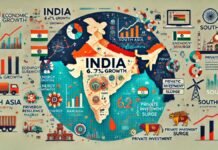
New Delhi: The International Monetary Fund (IMF) on Tuesday released its latest economic outlook for India, projecting a slowdown in the country’s gross domestic product (GDP) growth from 8.2% in 2023 to 7% in 2024. The IMF’s forecast suggests that India’s growth rate will further decline to 6.5% by 2025, citing the exhaustion of pent-up demand generated by the COVID-19 pandemic as a key factor behind the deceleration.
IMF’s Outlook: India’s Post-Pandemic Momentum Slows as Economy Stabilizes
The IMF’s downward revision reflects the view that India’s economy, while robust, is beginning to stabilize after a period of exceptional growth fueled by strong recovery demand post-pandemic. As businesses and consumers return to pre-pandemic activity levels, the extraordinary consumption and investment patterns seen in the aftermath of the COVID crisis are beginning to fade, leading to a moderation in growth.
The IMF’s projection aligns with similar assessments from other major financial institutions. Earlier this month, the Reserve Bank of India (RBI) revised its forecast, predicting India’s GDP growth to slow to 7.2% for the current fiscal year, driven by strong domestic demand. The World Bank has also tempered its expectations, projecting India’s economic growth to stabilize at 7% for fiscal year 2025.
Global Inflation Control: Progress Made, But Challenges Persist
On the global front, the IMF highlighted that the battle against inflation, which had surged in many major economies post-pandemic, has largely been won. However, the IMF cautioned that inflationary pressures remain in some countries, requiring ongoing vigilance.
IMF Chief Economist Pierre-Olivier Gourinchas emphasized the “unusually aggressive” measures taken by central banks worldwide to curb inflation, which helped stabilize the global economy. The IMF projects global economic growth to remain steady at 3.2% for both 2024 and 2025, although the pace of growth will vary across regions.
India’s Inflation Trends: From Peaks to Stability
India, which faced an inflation surge in recent years, has seen encouraging signs of price stabilization. In the third quarter of 2022, inflation soared to an annual high of 9.4%, driven by supply chain disruptions and soaring energy prices. However, inflation is expected to steadily decline to 3.5% by the end of 2025, dipping below the historical average of 3.6% seen between 2000 and 2019.
The Indian government’s latest data for September 2024 indicates an inflation rate of 5.5%, down from earlier highs. In July and August, inflation briefly dropped below 4%, signaling a period of relative price stability that is expected to continue in the near term.
Challenges Ahead for Developing Economies
While India’s growth remains comparatively strong, the IMF’s outlook also underscores challenges faced by other developing economies. The IMF has estimated that economic growth in developing nations will experience a significant slowdown over the next two years, as these countries grapple with rising costs of borrowing, sluggish exports, and global financial volatility.

For India, the coming years will require navigating the dual challenges of maintaining growth while managing inflationary pressures. Despite the projected slowdown, India remains one of the fastest-growing large economies in the world, with domestic consumption, infrastructure investments, and government policies playing a pivotal role in sustaining growth. However, as global uncertainties linger, the path ahead will demand careful balancing of economic strategies to ensure continued progress.
In conclusion, while India’s post-pandemic boom is beginning to normalize, the nation is well-positioned to tackle the headwinds, provided it continues to focus on sustainable growth and inflation control measures.



















































